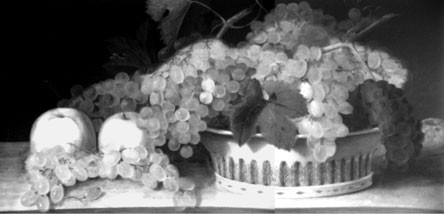 |
 James Peale James Peale
Still Life, 1825 |
Technical Notes
The support is a 1.2-centimeter-thick Eastern white pine panel. The panel has a 24.1-centimeter horizontal split extending from the left edge, which was stabilized with a wooden splint glued to the back during a 1975 treatment. The back of the panel is painted reddish brown and shows fore-plane marks. An examination in 1974 revealed that the red paint contains lead.
The white ground layer has a slightly pebbled surface that shows through the upper paint layers. Chemical tests in 1974 confirmed the presence of both white lead and calcium carbonate in the ground layer. The ground, which does not completely obscure the grain texture of the panel, was applied in wide horizontal brushstrokes in a moderate thickness.
The paint is built up with thinly applied layers. It appears that Peale painted the background first, leaving large areas in reserve for the fruit of the still life. Examination with a Hamamatsu infrared vidicon camera shows clearly how the edges of the reserve extend slightly under the edges of the fruit (fig.1). The bunches of grapes were first underpainted with an overall thin application of general color. The shapes of the grapes were then developed with fine, thinly applied brushstrokes working wet-on-wet. White highlights were added after the underlying colors had partially dried. The grape stems were painted after the underlying paint was dry. Glazes are present on the bowl and on some of the fruit. The color of the wooden tabletop was achieved with a thin application of reddish-brown earth tones over the white ground.
|
|
|
 |
 |
Figure 1. Infrared reflectogram showing James Peale's method of leaving the overall
contour of the still-life objects in reserve while painting the background.
|
Overall, the condition of the paint surface is very good. There are a few scattered losses, mainly around the edges. The paint has a branched network of both age and drying cracks. Some of the drying cracks show underlying paint that has pushed up between the cracks; this is most marked on the bowl, where the paint surface appears slightly wrinkled.
There is some inpainting of drying cracks, mostly in the upper right of the background and the bottom center of the table. Solvent damage is visible on some tops of the pebbled texture, revealing the underlying ground layer.
The present varnish layer consists of layers of Acryloid B-72, applied in 1975 and 1979. The varnish is evenly applied in a moderately thick layer and appears somewhat matte. |